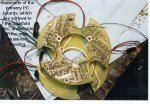Steve2381
Senior Member
Hi all
Currently trying to transfer my car lighting controller over from its current breadboard build, to a nice PCB.
Designing it on Express PCB, and will have a go at various methods of transferring it to a board (can't afford the actual PCBExpress price of £179!)
My question is that of power rating of the copper strips. I currently have 10x standard car 30A relays (the type with Lucas terminals on them), but plan to switch over and use something like these:
http://www.rapidonline.com/design-technology/omron-g8p-spno-30a-pcb-relay-518300
How do you know what width to make the PCB track to take a certain load? I am assuming basically... make them as wide as I can!
As a quick add on question.... the method of ironing photo paper onto a cleaned PCB board... does that work well on thin tracked detailed boards?
Currently trying to transfer my car lighting controller over from its current breadboard build, to a nice PCB.
Designing it on Express PCB, and will have a go at various methods of transferring it to a board (can't afford the actual PCBExpress price of £179!)
My question is that of power rating of the copper strips. I currently have 10x standard car 30A relays (the type with Lucas terminals on them), but plan to switch over and use something like these:
http://www.rapidonline.com/design-technology/omron-g8p-spno-30a-pcb-relay-518300
How do you know what width to make the PCB track to take a certain load? I am assuming basically... make them as wide as I can!
As a quick add on question.... the method of ironing photo paper onto a cleaned PCB board... does that work well on thin tracked detailed boards?

